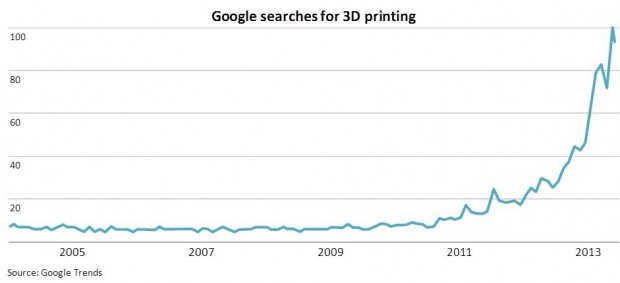A few weeks ago whilst trying to cram even more stuff into my freezer I snapped the plastic front cover of the freezer drawer, much to the annoyance of my other half. Since the freezer model is now discontinued it took me hours to track down the spare part online, which was eventually shipped to me from Germany. However, these sorts of everyday frustrations could soon be a thing of the past as low-cost 3D printers are hitting the market.
Additive manufacturing, more commonly known as 3D printing, is a process of producing three-dimensional solid objects from digital designs. 3D printers work in exactly the same way as your inkjet printer at home but, instead of ink, they deposit the desired material, ranging from plastics to concrete and chocolate, in successive layers slowly to build up a 3D object. The recent media hype can make 3D printing feel like a new technology but it has in fact been slowly evolving since the mid-1980s, although its true potential has only hit the headlines now that a dramatic drop in the printer cost has led to consumer models selling for less than £250. Combined with the increasing availability of low-cost 3D scanners, it may not be long before consumers readily have the technology to scan any off-the-shelf product and print a replica at home. Of course that raises a lot of other issues - not least from an IP viewpoint.

Last month, the Business Secretary Vince Cable announced that the Technology Strategy Board and Research Councils are investing £8.4m to help boost UK businesses to develop new 3D printing solutions. 18 innovative projects across a wide range of industries will receive funding, including projects to develop bespoke 3D cranio-facial implants for head trauma patients, make personalised insoles for your shoes, and improve the processes for 3D printed gold jewellery. The government has also recently announced that the new-look national curriculum will include lessons on 3D printing in Design and Technology classes.
The IPO is taking a particular interest in 3D printing because it raises a number of issues in relation to IP protection. Of course this isn’t the first time that this has happened with new technological advances – over the years a variety of opportunities and challenges have arisen for IP creators, owners and users alike from the development of the camera and phonorecords through to the evolution of the internet. Similar IP debates can be expected to develop as 3D printing hits the mass market, although this time the implications for copyright, design right, trade marks and patents means the legal framework is even more diverse. As the cost of 3D printers gets ever closer to that of household inkjet printers, one of the biggest potential IP issues surrounding 3D printers is in the manufacture of items for personal use, especially given the current private use exemptions under patent law and design law.
To this end, later this year the IPO will be looking at 3D printing and its potential to change how we learn, create and manufacture. Analysts within the Patent Informatics team will be looking at the current 3D printing patent landscape and whether UK businesses are well positioned to benefit from this potentially disruptive technology. 3D Printing is also a key part of the Economics, Research and Evidence’s research programme for 2013-2014.
The IP system certainly has an integral role to play as the 3D printing industry evolves. The IPO is keen to lay the foundations so that UK businesses can benefit from this emerging technology as it is likely to transform manufacturing in the next decade. In recent months, the media coverage of 3D printing seems to be increasing by the week with bespoke 3D printing solutions being used in all sorts of weird and wonderful ways including exo-skeletal casts for broken bones, dresses, meat, aircraft, prosthetic limbs for animals, food for astronauts, bionic ears, sugarcraft for baking, and the steering wheel for the 1000mph Bloodhound SSC, as well a more controversial use in the production of 3D printed guns.
It is clear that, what was once a science-fiction fantasy, may soon be reality. Can 3D printing really be a game-changer? We will have to wait and see. But maybe next time I clumsily smash things at home, I will just click a button and print a replacement on demand.
ERE is looking at doing more research in this area. If you're interested, please get in touch via email to research@ipo.gov.uk.
If you have questions or feedback, do comment on this blogpost and we’ll do our best to respond.
To keep in touch, sign up to email updates from this blog, or follow us on Twitter using the #IPOFACTO hashtag.
3 comments
Comment by Iona Silverman posted on
Great post Chris. I have been doing some thinking about 3D printing and fashion so it's good to know it's an area the IPO is interested in.
Comment by Chris Harrison posted on
Virgil - thanks for your comments. Since writing the blog, I've seen this article online (http://boingboing.net/2013/07/22/get-ready-for-the-big-bang-as.html) which I presume is the one to which you refer; it is certainly a fast evolving technology space and the impact of expiring key patents could potentially lead to increased sales of 3D printers as their cost continues to fall. All I can say is watch this space in the near future for more information on the IPO research projects relating to 3D printing.
Comment by Virgil posted on
Great post Chris, very interesting subject. I'd be very interested to hear about any other work that's being done on 3D printing in the office.
I've also read recently that the boom in 3D printing tech has coincided with the expiry of crucial 3D printing patents - so were patents holding back 3D printing innovation? Or maybe 3D printing would have never come about in the first place without them.